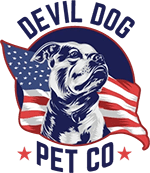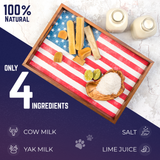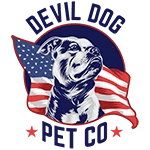Key Takeaways
- Strict supervision is essential to prevent unwanted pregnancies during a dog’s heat cycle.
- Maintaining proper hygiene with quality diapers and enzymatic cleaners helps manage cleanliness effectively.
- Providing mental enrichment, such as long-lasting chews, supports behavioral health and reduces anxiety.
- The heat cycle typically lasts 2-4 weeks and occurs approximately every 6 months.
Table of Contents
- What Does It Mean When a Dog Is "In Heat"?
- Understanding the Canine Heat Cycle: Stages, Timing & What to Expect
- Spotting the Signs: Physical & Behavioral Changes
- Essential Dog in Heat Care: Daily Routines, Comfort, and Hygiene
- Preventing Unwanted Pregnancies: Responsibility, Readiness & Real-World Barriers
- Managing Behavioral and Emotional Ups & Downs
- Clean Home, Happy Dog: Managing Mess and Odors
- Special Considerations for Puppies, Seniors, and Multi-Dog Homes
- When to Call the Vet, Warning Signs You Can't Ignore
- Dog in Heat vs. Other Situations: Key Differences
Dog in Heat Care: The No-Nonsense Guide
What Does It Mean When a Dog Is "In Heat"?
When a dog is "in heat," she's experiencing estrus, the fertile phase of her reproductive cycle where pregnancy can occur. Unlike human menstruation, this isn't about shedding uterine lining; it's nature's preparation for ovulation and breeding. Your unspayed female becomes hormonally driven to mate, attracting males from significant distances.
This cycle brings dramatic physical and behavioral changes: vulva swelling, bloody discharge, increased urination, mood swings, and escape attempts. The discharge progresses from bright red to pink or straw-colored as fertility peaks around days 10-14. Long-lasting chews can be especially helpful for managing anxiety and providing healthy distraction during this time.
As the owner, your primary responsibility centers on preventing accidental pregnancies while supporting your dog's physical comfort and emotional needs. Proper dog in heat care means becoming your dog's security detail, hygienist, and behavioral coach all at once. For additional support, consider these tips for managing separation anxiety in dogs during stressful cycles.
Understanding the Canine Heat Cycle: Stages, Timing & What to Expect

Overview & Frequency
Most dogs cycle every 6 months, though smaller breeds may heat up to 3 times yearly while giant breeds often cycle just once. First heat typically arrives between 6-18 months, toy breeds as early as 6 months, large breeds sometimes waiting until 24 months. Unlike humans, dogs don't experience menopause; they'll cycle throughout their lives unless spayed.
Critical Timing: Each heat lasts 2-4 weeks total, with peak fertility occurring during days 10-14 when discharge lightens and your dog becomes receptive to mating.
The Four Stages Explained
Proestrus (7-10 days): Vulva swells, bloody discharge begins, males show interest but females reject advances. Your dog may seem restless or clingy.
Estrus (5-10 days): The fertile window opens. Discharge lightens to pink or clear, your dog "flags" her tail to the side, and she becomes receptive to breeding. This is when pregnancies occur.
Diestrus (10-140 days): Fertility ends, hormones normalize, and discharge stops. If pregnant, this phase covers gestation and nursing.
Anestrus (2-5 months): Complete reproductive rest until the next cycle begins.
Spotting the Signs: Physical & Behavioral Changes
Physical Indicators
The vulva swells to 2-3 times normal size, becoming firm and protruding. Discharge starts bright red and heavy, progressing to lighter pink or straw-colored as estrus approaches. You'll notice increased urination and marking, your dog's calling card to potential suitors. Some dogs experience mild nipple swelling, though this isn't universal.
Behavioral Changes
Hormonal surges create dramatic personality shifts. Your normally calm dog might become clingy, following you room to room, or conversely, seem irritable and withdrawn. Many dogs exhibit mounting behaviors, humping pillows, other dogs, or even your leg. The most concerning change is escape behavior: digging under fences, bolting through doors, or attempting seemingly impossible jumps.
When our dog Dexter experienced her first heat, the persistent whining and door-scratching caught us off-guard. We learned that providing structured comfort through routine and appropriate chews helped channel that anxious energy productively. If you're interested in healthy treat options, explore this comprehensive guide to single ingredient dog treats.
Essential Dog in Heat Care: Daily Routines, Comfort, and Hygiene
Supervision & Security
Your dog stays indoors except for controlled, leashed bathroom breaks. Even a fenced yard requires constant supervision, males can jump surprisingly high fences or dig underneath when motivated. Double-check all gate latches and fence lines twice daily. Install baby gates at key doorways to create airlocks preventing bolt attempts.
Hygiene and Cleanliness Management
Quality doggy diapers become essential equipment. Change every 3-4 hours, applying barrier cream to prevent chafing around leg openings. Clean discharge daily with unscented, damp cloths, avoid harsh soaps that can irritate sensitive tissue. Enzymatic cleaners handle accidents effectively, breaking down proteins that cause lingering odors.
Washable bedding covers and rubber-backed rugs in high-traffic areas protect your furniture and floors. Keep cleaning supplies easily accessible, you'll need them.
Creating a Calm, Comfort-First Environment
Establish a quiet retreat space where your dog can decompress. Limit visitors and new stimulations that might increase anxiety. This is where proper dog in heat care includes mental enrichment through appropriate chews. Yak chews and bully sticks provide extended engagement, helping channel anxious energy into productive activity while supporting dental health.
Adjust exercise routines toward indoor mental games when outdoor walks become challenging. Puzzle feeders, frozen treats, and rotating chew options maintain enrichment without exposure risks. For more tips on maintaining your dog's dental health, see this expert advice for maintaining your pet's dental health.
Preventing Unwanted Pregnancies: Responsibility, Readiness & Real-World Barriers

A female in estrus attracts males from miles away through pheromones, intact males will scale 6-foot fences, dig under barriers, or wait patiently outside your home for any opportunity. Even a 30-second unsupervised encounter during peak fertility can result in pregnancy. This isn't about being paranoid; it's about understanding canine biology and taking ownership of the consequences.
Extreme Leadership Reality Check: If you can't commit to 24/7 supervision for 2-4 weeks, you're not ready for intact female ownership. No exceptions.
Create physical barriers that work: double-gate systems, indoor baby gates creating "airlocks," and never trust leash hand-offs to family members outdoors. In multi-dog households with intact males, complete separation becomes mandatory, separate feeding areas, crate rotations, and room dividers. One neighbor's "just five minutes" unsupervised backyard break resulted in an unplanned litter of 8 puppies.
Long-term solutions include spaying discussions with your veterinarian. Timing matters, some vets recommend spaying before the first heat to reduce cancer risks, while others prefer waiting until physical maturity. Heat suppression medications exist but carry risks and require veterinary oversight. The responsible choice depends on your specific situation and commitment level. For more in-depth information, visit this comprehensive dog heat cycle FAQ from the AKC.
Managing Behavioral and Emotional Ups & Downs
Hormonal fluctuations create anxiety, restlessness, and mood swings that require structured comfort responses. Maintain predictable routines, same feeding times, consistent crate schedules, and familiar spaces reduce stress triggers. Classical music or white noise machines help mask outside sounds that might increase agitation.
Mental enrichment becomes crucial when physical exercise is limited. Frozen yak chews provide 45-60 minutes of focused engagement, while bully sticks offer protein-rich satisfaction for shorter sessions. These aren't just treats, they're behavioral management tools that redirect anxious energy into productive chewing while supporting dental health.
Handle mood swings through redirection, not confrontation. When your dog becomes snappy or withdrawn, guide them to their comfort space with a high-value chew rather than scolding. Set clear boundaries with guests and children, establish a "three-foot rule" during heat cycles and post visual reminders on doors.
For extreme behaviors like escape attempts or destructive chewing, preemptive action works best. Inspect fence lines and door locks twice daily, provide appropriate outlets before problems start, and keep long-lasting chews readily available for immediate redirection.
Clean Home, Happy Dog: Managing Mess and Odors
Quality dog diapers make the difference between manageable care and constant cleanup. Disposable options offer convenience and maximum absorption, look for leak-proof barriers and adjustable tabs that prevent chafing. Washable diapers prove more economical for multiple cycles but require immediate laundering to prevent odor buildup.
| Diaper Type | Absorption Capacity | Cost Per Use | Skin Comfort | Convenience |
|---|---|---|---|---|
| Disposable Premium | 8-12 hours protection | $2-3 per day | Soft, breathable materials | Toss and replace |
| Washable Cotton | 4-6 hours before change | $0.50 per day | Natural fiber comfort | Wash cycle required |
| Hybrid Systems | 6-8 hours with inserts | $1-1.50 per day | Customizable padding | Insert replacement only |
Enzymatic cleaners specifically designed for pet accidents break down proteins that cause persistent odors, standard household cleaners often mask smells rather than eliminating them. Keep washable throws over furniture in high-traffic areas and rubber-backed rugs near doors and feeding stations.
Natural odor control focuses on ventilation and prevention rather than masking. Open windows when weather permits, run air purifiers with activated carbon filters, and maintain outdoor potty areas with regular hosing and enzymatic treatments. Pet-safe air fresheners work better than strong chemicals that might irritate sensitive respiratory systems during this stressful period. For more on keeping your dog happy and healthy in different environments, check out these tips for taking your dog camping this summer.
Special Considerations for Puppies, Seniors, and Multi-Dog Homes

Puppies experiencing their first heat often show heightened confusion and anxiety, they don't understand the physical changes or hormonal urges. Provide extra comfort through shortened outdoor sessions, increased crate time with familiar blankets, and gentle reassurance. First cycles sometimes prove irregular in timing or intensity, making veterinary guidance valuable for establishing normal baselines.
Senior dogs continue cycling throughout their lives, but age brings increased health risks. Pyometra (uterine infection) rates climb significantly after age 6, making careful monitoring essential. Older dogs may experience mobility challenges during heat, provide easier access to comfortable resting areas and consider orthopedic bedding for joint support.
Multi-dog households require military-precision scheduling when intact males are present. Separate feeding prevents resource guarding conflicts, crate rotations ensure everyone gets attention without proximity stress, and visual barriers reduce constant stimulation. Even neutered males may show increased interest, requiring management strategies.
Chew rotation becomes especially important in crowded households, each dog needs individual enrichment opportunities. Create a schedule ensuring everyone receives appropriate mental stimulation without competition or resource. For more on reproductive health and cycle management, see this detailed guide to dog estrous cycles from Cornell University.
When to Call the Vet, Warning Signs You Can't Ignore
Potential Medical Concerns
Pyometra represents the most serious heat-related emergency. This uterine infection develops when bacteria enter through the dilated cervix, creating a life-threatening situation within hours. Watch for lethargy, excessive thirst, vomiting, and pus-filled discharge.
Abnormal bleeding patterns also demand immediate attention. Normal discharge progresses from bright red to pink to straw-colored over 2-3 weeks. Heavy bleeding soaking through multiple diapers daily, bleeding lasting beyond 21 days, or sudden cessation followed by illness symptoms require same-day veterinary evaluation.
Reproductive Disorders & Heat Cycle Irregularities
Skipped cycles in adult females may indicate underlying health issues, from thyroid dysfunction to ovarian cysts. Conversely, late first heats in giant breeds are often normal, but toy breeds not cycling by 15 months need evaluation.
Silent heats, cycles with minimal external signs, can fool owners into thinking their dog isn't cycling. If you suspect your female should be in heat but shows no obvious signs, request hormone testing to confirm reproductive status.
Pregnancy Risks & Complications
Accidental pregnancies in very young or senior dogs carry elevated risks. Puppies under 18 months lack fully developed pelvises, while seniors face increased complications from decreased muscle tone and potential underlying health conditions.
Veteran Insight: Trust your instincts. If something feels "off" about your dog's heat cycle, duration, discharge color, behavior changes, call your vet. False alarms beat missed emergencies every time.
Dog in Heat vs. Other Situations: Key Differences
Dog in Heat vs. Spayed Female
| Criteria | Dog in Heat | Spayed Female |
|---|---|---|
| Behavioral Changes | Mood swings, increased marking, escape attempts | Stable behavior patterns year-round |
| Pregnancy Risk | High during estrus phase | Zero risk |
| Physical Discharge | Bloody to straw-colored over 2-3 weeks | None |
| Health Implications | Risk of pyometra, mammary tumors | Eliminated reproductive cancers |
Disposable vs. Washable Dog Diapers
| Feature | Disposable Diapers | Washable Diapers |
|---|---|---|
| Cost Per Use | $0.75-$1.50 each | $0.25-$0.50 after initial investment |
| Absorption | High, single use | Moderate, reusable |
| Convenience | Easy, no laundry | Requires washing |
| Eco Impact | Landfill waste | Lower waste, reusable |
Frequently Asked Questions
What are the key physical and behavioral signs that indicate a dog is in heat?
Look for vulva swelling, bloody discharge that changes from bright red to pink or straw-colored, increased urination, mood swings, and attempts to escape. Behaviorally, your dog may become more restless, anxious, or seek attention more than usual.
How long does a typical heat cycle last and how often do dogs usually go into heat?
A typical heat cycle lasts between 2 to 4 weeks. Most dogs go into heat about every 6 months, though smaller breeds may cycle up to three times a year, and larger breeds often cycle just once annually.
What are the best practices for preventing unwanted pregnancies during a dog's heat cycle?
Strict supervision is essential, keep your dog isolated from intact males and use snug, breathable dog diapers changed frequently. Leash walks and secure environments help prevent escapes and accidental breeding.
How can I effectively manage hygiene and behavioral changes in my dog while she is in heat?
Maintain cleanliness with quality diapers and enzymatic cleaners to manage discharge and odors. Provide mental enrichment like long-lasting chews to reduce anxiety and support behavioral health during this stressful time.






